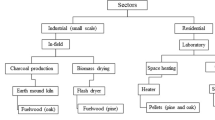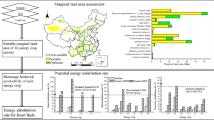Abstract
Finland considers energy production from woody biomass as an efficient energy planning strategy to increase the domestic renewable energy production in order to substitute fossil fuel consumption and reduce greenhouse gas emissions. Consequently, a number of developmental activities are implemented in the country, and one of them is the installation of second generation liquid biofuel demonstration plants. In this study, two gasification-based biomass conversion technologies, methanol and combined heat and power (CHP) production, are assessed for commercialization. Spatial information on forest resources, sawmill residues, existing biomass-based industries, energy demand regions, possible plant locations, and a transport network of Eastern Finland is fed into a geographically explicit Mixed Integer Programming model to minimize the costs of the entire supply chain which includes the biomass supply, biomass and biofuel transportation, biomass conversion, energy distribution, and emissions. The model generates a solution by determining the optimal number, locations, and technology mix of bioenergy production plants. Scenarios were created with a focus on biomass and energy demand, plant characteristics, and cost variations. The model results state that the biomass supply and high energy demand are found to have a profound influence on the potential bioenergy production plant locations. The results show that methanol can be produced in Eastern Finland under current market conditions at an average cost of 0.22 €/l with heat sales (0.34 €/l without heat sales). The introduction of energy policy tools, like cost for carbon, showed a significant influence on the choice of technology and CO2 emission reductions. The results revealed that the methanol technology was preferred over the CHP technology at higher carbon dioxide cost (>145 €/tCO2). The results indicate that two methanol plants (360 MWbiomass) are needed to be built to meet the transport fuel demand of Eastern Finland.





Similar content being viewed by others
References
European Commission (2007) Commission of the European Communities 2007. Communication from the commission to the council and the European Parliament-renewable energy road map; Renewable energies in the 21st century: building a more sustainable future. COM (2006) 848 final. Brussels 10.01.2007
European Commission (2009) Directive 2009/28/EC of the European Parliament and of the Council of 23 April 2009 on the promotion of the use of energy from renewable sources and amending and subsequently repealing Directives 2001/77/EC and 2003/30/EC. COD (2008)0016. Brussels 23.04.2009
Ministry of Trade and Industry (2008) Government’s ministerial working group on climate and energy Policy 2008. Long-term climate and energy strategy. Government report to Parliament p 130 (In Finnish) http://www.tem.fi/files/20585/Selontekoehdotus_311008.pdf. Cited 21 Nov 2010
Metla (2009) Finnish statistical yearbook of forestry. http://www.metla.fi/julkaisut/metsatilastollinenvsk/index-en.htm. Cited 17 Oct 2010
European Commission (2007) Commission Decision of 18 July 2007 establishing guidelines for the monitoring and reporting of greenhouse gas emissions pursuant to Directive 2003/87/EC of the European Parliament and of the Council (notified under document number C(2007) 3416) (2007/589/EC) July 2007
Freppaz D, Minciardi R, Robba M et al (2004) Optimizing forest biomass exploitation for energy supply at a regional level. Biomass Bioenergy 26(1):15–25
Morrow WR, Griffin WM, Matthews HS (2006) Modeling switchgrass derived cellulosic ethanol distribution in the United States. Envi Sci Tech 40(9):2877–2886
Eksioglu S, Acharya A, Leightley L et al (2009) Analyzing the design and management of biomass-to-biorefinery supply chain. Comp Ind Engi 57(4):1342–1352
Rentizelas A, Tatsiopoulos I, Tolis A (2009) An optimization model for multi-biomass tri-generation energy supply. Biomass Bioenergy 33(2):223–233
Zamboni A, Shah N, Bezzo F (2009) Spatially explicit static model for the strategic design of future bioethanol production systems. 1. Cost minimization. Ener Fuel 23(10):5121–5133
Parker N, Tittmann P, Hart Q et al (2010) Development of a biorefinery optimized biofuel supply curve for the Western United States. Biomass Bioenergy 34(11):1597–1607
Huang Y, Chen C, Fan Y (2010) Multistage optimization of the supply chains of biofuels. Transportation Research Part E: Logi Tran Revi 46(6):820–830
Azar C, Lindgren K, Andersson BA (2003) Global energy scenarios meeting stringent CO2 constraints-cost-effective fuel choices in the transportation sector. Energy Policy 31(10):961–976
Wahlund B, Yan J, Westermark M (2004) Increasing biomass utilisation in energy systems: a comparative study of CO2 reduction and cost for different bioenergy processing options. Biomass Bioenergy 26(6):531–544
Schmidt J, Leduc S, Dotzauer E et al (2010) Cost-effective CO2 emission reduction through heat, power and biofuel production from woody biomass: a spatially explicit comparison of conversion technologies. Applied Energy 87(7):2128–2141
Börjesson M, Ahlgren EO (2010) Biomass gasification in cost-optimized district heating systems—a regional modelling analysis. Energy Policy 38(1):168–180
Grahn M, Azar C, Williander MI, Anderson JE, Mueller SA, Wallington TJ (2009) Fuel and vehicle technology choices for passenger vehicles in achieving stringent CO2 targets: connections between transportation and other energy sectors. Envi Scie Tech 43(9):3365–3371
Berndes G, Hansson J (2007) Bioenergy expansion in the EU: cost-effective climate change mitigation, employment creation and reduced dependency on imported fuels. Energy Policy 35(12):5965–5979, Special section on Modeling socio-economic aspects of bioenergy use
Turton H, Barreto L (2007) Automobile technology, hydrogen and climate change: a long term modeling analysis. Int J Alter Propulsion 1:397–426
Gielen D, Fujino J, Hashimoto S et al (2003) Modeling of global biomass policies. Biomass Bioenergy 25(2):177–195
Sohlström H (2007) UPM ja biopolttoainekehitys. Paper presented at WWF-SFS seminar, Helsinki, Finland
Jääskelainen A (2008) Bio refineries business prospects for the Finnish industry. Tekes BioRefine programme
Mäkinen T, Leppälahti J (2009) Review of the Finnish BioRefine—new biomass products program. Envi Pro Sus Energy 28(3):470–474
Wolsey L (1998) Integer programming. Wiley, New York
Leduc S, Schwab D, Dotzauer E et al (2008) Optimal location of wood gasification plants for methanol production with heat recovery. Int J Ener Resear 32(12):1080–1091
Leduc S, Schmid E, Obersteiner M et al (2009) Methanol production by gasification using a geographically explicit model. Biomass Bioenergy 33(5):745–751
Leduc S, Lundgren J, Franklin O et al (2010) Location of a biomass based methanol production plant: a dynamic problem in northern Sweden. Applied Energy 87(1):68–75
Bååth H, Gällerspång A, Hallsby G et al (2002) Remote sensing, field survey, and long-term forecasting: an efficient combination for local assessments of forest fuels. Biomass Bioenergy 22(3):145–157
Tomppo E, Haakana M, Katila M et al (2009) The multi-source national forest inventory of Finland - methods and results 2005. www.metla.fi/julkaisut/workingpapers/2009/mwp111.pdf. Cited 21 March 2010
Harstela P, Kiljunen N (2001) Hakkuutahteen maaran arviointi koneellisen puunkorjuun yhteydessa-PUUT03, VTT. (In Finnish)
Keskimolo A (1997) Energiapuuvarat ja niiden hyodyntamiseddellytykset. Loppuraportti.Bioenergian tutkimusohjelma:32p.(In Finnish)
Siitonen M, Härkönen K, Hirvelä H et al (1996) MELA Handbook-1996 Edition. The Finnish Forest Research Institute. Research Papers 622: 452
Parikka M (2000) Biosims—a method for the calculation of woody biomass for fuel in Sweden. Ecol Eng 16(Sup 1):73–82
Ranta T (2005) Logging residues from regeneration fellings for biofuel production—a GIS based availability analysis in Finland. Biomass Bioenergy 28(2):171–182
Marklund LG (1988) Biomass functions for pine, spruce and birch in Sweden. Sveriges Lantbruksuniversitet, Uppsala, Sweden, Inst. Skogstaxering. Rapp. 45
Panichelli L, Gnansounou E (2008) GIS modelling of forest wood residues potential for energy use based on forest inventory data: Methodological approach and case study application. Paper presented at iEMSs 2008, International Congress on Environmental Modelling and Software, Barcelona
Power Engineering (2008) Forest industry and Sawmill map of Finland-2008 (Personal communication)
Tanner M (2010) District heating customers 2008. Energiateollisuus ry (Personal communication), Helsinki
Heikkilä J, Sirén M, Äijälä O (2007) Management alternatives of energy wood thinning stands. Biomass Bioenergy 31(5):255–266
Heikkilä J, Sirén M, Ahtikoski A et al (2009) Energy wood thinning as a part of the stand management of scots pine and Norway spruce. Silva Fenn 43(1):129–146
World Resource Institute (2010) Energy and resources. Earth trends—the environmental information portal. http://earthtrends.wri.org/. Cited 14 Mar 2010
Finnish Energy Industry (2009) Statistics-district heating year 2009. http://www.energia.fi/fi/kaukolampo/kaukolampo/tilastointi. Cited 03 Mar 2010
Asikainen A (2003) Productivity, cost and availability factors of forest chip production. Bioenergy 2003. International nordic bioenergy conference proceedings. 221–224p
Anttila P, Tahvanainen T, Parikka H et al (2007) Energy wood transportation by Rail. METLA publications, 5 EURES-EIE/04/086/S07.38582:17
Penttinen A (2010) Liquid fuel transportation. Kiitosimeon Ltd (Personal communication), Mikkeli
Viinamaki L (2010) VR Logistics. VR-Group Ltd (Personal communication), Vainikkala
Faaij A (2006) Modern biomass conversion technologies. Mitigation and adaptation strategies for global change 11(2):335–367
Hamelinck CN, Faaij AP (2002) Future prospects for production of methanol and hydrogen from biomass. J Pow Sources 111(1):1–22
Williams R, Larson E, Katofsky R et al (1995) Methanol and hydrogen from biomass for transportation (1). Ene sust devlop 1(5):18–34
Zhang W (2010) Automotive fuels from biomass via gasification. Fuel Pro Tech 91(8):866–876
Dornburg V, Faaij A (2001) Efficiency and economy of wood-fired biomass energy systems in relation to scale regarding heat and power generation using combustion and gasification technologies. Biomass Bioenergy 21(2):91–108
Schmidt J, Leduc S, Dotzauer E et al (2010) Potential of biomass-fired combined heat and power plants considering the spatial distribution of biomass supply and heat demand. Int J Ener Resear 34(11):970–985
Kurkela E (2002) Review of Finnish biomass gasification technologies. OPET, Espoo
Craig K, Mann M (1996) Cost and performance analysis of biomass-based integrated gasification combined-cycle (BIGCC) power systems. National renewable energy laboratory, Colorado
Marbe Å, Harvey S, Berntsson T (2004) Biofuel gasification combined heat and power—new implementation opportunities resulting from combined supply of process steam and district heating. Energy 29(8):1117–1137
Parsons E, Shelton W, Lyons J (2002) Advanced fossil power systems comparison study. National energy technology laboratory, US department of energy, Morgantown
Sørensen Å, Nilsson S (2005) Economies of scale in biomass gasification systems. International Institute for Applied Systems Analysis, Austria, pp 05–030
IPCC (1996) Revised 1996 IPCC guidelines for national greenhouse gas inventories. In: Houghton JT, Eira F, Lim B, Bonduki Yet al, B.A.IPCC/OECD/IEA, UK Meteorological Office, Bracknell. www.ipccnggip.iges.or.jp/public/gl/invs1.html. Cited 23 Feb 2010
Statistics Finland (2008) Greenhouse gases—carbon dioxide emissions in Finland 1995–2008. Environment and Natural Resources, http://www.stat.fi. Cited 11 Apr 2010
Hilmola O, Saranen J, Padilha F (2010) Location criteria and strategic factors of biodiesel factory establishment in Finnish context. Department of industrial management, Lappeenranta University of technology, research report 219. http://www.doria.fi/lutpub. Cited 21 Dec 2010
Acknowledgments
The Centre for International Mobility (CIMO-Finland) as well as the EC projects CC-Tame and Pashmina are gratefully acknowledged for their financial support. The authors thank the cooperation and support from the partner research institutions mainly International Research Institute for Applied System Analysis (IIASA) and Finnish Forest Research Institute (METLA).
Author information
Authors and Affiliations
Corresponding author
Rights and permissions
About this article
Cite this article
Natarajan, K., Leduc, S., Pelkonen, P. et al. Optimal Locations for Methanol and CHP Production in Eastern Finland. Bioenerg. Res. 5, 412–423 (2012). https://doi.org/10.1007/s12155-011-9152-4
Published:
Issue Date:
DOI: https://doi.org/10.1007/s12155-011-9152-4




